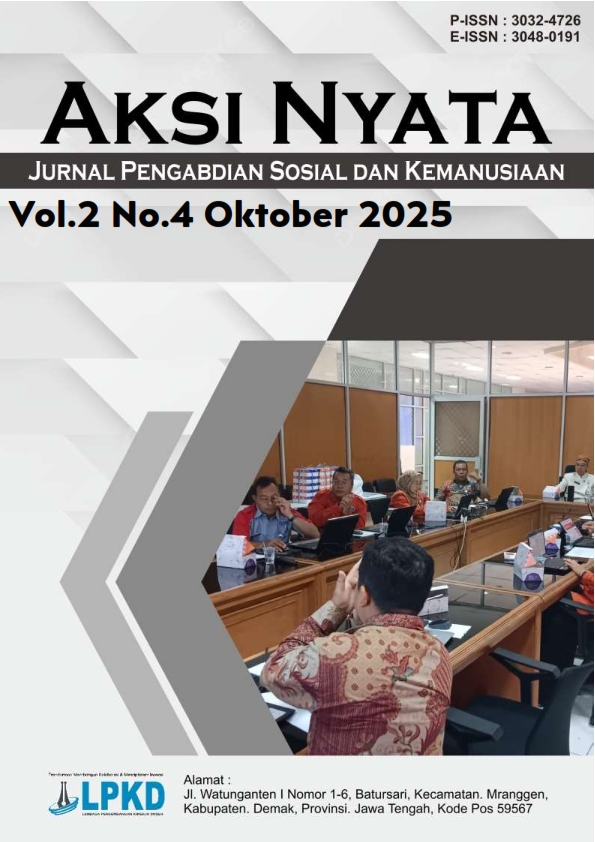Implementasi Talent Management System dalam Mengembangkan High Potensial Employee : Studi Succession Planning PT. Surya Pratista Hutama
DOI:
https://doi.org/10.62383/aksinyata.v2i4.2210Keywords:
High-Potential Employees, Human Resource Management, Leadership Development, Success Plan, Talent Management ProgramAbstract
Increasing competition in the food industry requires companies to not only focus on product innovation and market expansion but also on strengthening internal human resource capabilities through long-term strategies. PT. Surya Pratista Hutama addresses this challenge by implementing a Talent Management Sistem (TMS) designed to identify, develop, and retain high-potential employees (HiPos), while simultaneously ensuring sustainable leadership development and succession planning. This study employed a qualitative case study approach by utilizing observations, in-depth interviews, and a paper review to obtain comprehensive insights into the company’s practices. The findings reveal that the identification of HiPos is carried out through a rigorous and consistent process using the 9-box grid as a key assessment tool. The emphasis on consistency in evaluation highlights the organization’s effort to ensure fairness and accuracy. Employee development is facilitated through multiple strategies, including formal training, mentoring programs, job rotation, and other structured learning initiatives. Retention strategies focus on providing competitive compensation packages, developing financial literacy skills, and fostering a collaborative organizational culture that values employee contributions. The implementation of TMS at PT. Surya Pratista Hutama has shown positive impacts, particularly in reducing employee turnover rates and improving leadership performance. However, the study also identifies several challenges, especially related to the need for clearer procedural guidelines and more specific development strategies to optimize outcomes. Overall, this research demonstrates that a well-structured TMS can serve as an effective mechanism for building sustainable human resource capabilities in highly competitive industries such as food manufacturing.
References
Armstrong, M. (2014). Armstrong's handbook of human resource management practice (13th ed.). Kogan Page.
Chennappa, D., & Chaitanya, M. (2024). Talent retention strategies in human resource management: A structured performance and career planning approach. International Journal of Human Resource Studies, 14(2), 45-59.
Collings, D. G., & Mellahi, K. (2009). Strategic talent management: A review and research agenda. Human Resource Management Review, 19(4), 304-313. https://doi.org/10.1016/j.hrmr.2009.04.001
Elugbaju, A. F., Adeola, O., & Salau, O. (2024). Human resource analytics and succession planning: Enhancing organizational sustainability. Journal of Human Capital Development, 19(1), 77-95.
Groenewald, E. S., Groenewald, C. A., Kilag, O. T., Andrin, G. R., Pernites, M. F., & Macapaz, M. S. (2024). Talent management in the 21st century: A comprehensive review and prospects for innovation. International Multidisciplinary Journal of Research for Innovation, Sustainability, and Excellence, 1(3), 93-99. https://orcid.org/0000-0001-7813-2773
Hartati, V., & Giovanni, A. (2022). Perspektif pengembangan digital talent era industri 4.0. Jurnal AKMENIKA, 19(1), 614-621. https://doi.org/10.31316/akmenika.v19i1.2637
Hausknecht, J. P., Rodda, J., & Howard, M. J. (2009). Targeted employee retention: Performance‐based and job‐related differences in reported reasons for staying. Human Resource Management, 48(2), 269-288. https://doi.org/10.1002/hrm.20279
Hidayah, R., & Kristanto, B. (2025). Talent management implementation strategy to increase retention in managerial positions: Case study in Banjarbaru city. Dinasti International Journal of Education Management and Social Science, 6(3), 1933-1942. https://doi.org/10.38035/dijemss.v6i3.3866
Khan, R., & Jamil, F. (2024). Talent management and organizational competitiveness: Preparing future leaders. Asian Journal of Management Research, 15(1), 23-40.
King, K., & Vaiman, V. (2021). Enabling effective talent management through a macro-contingent approach to HRM. Human Resource Management Review, 31(3), 100-125.
Kurniawan, H., & Shaura, R. K. (2023). Implementation of talent management: Strategies for retaining high potential employees in a competitive era. Jurnal Ekonomi, 12(3), 1578-1583.
Petu, J., Mandagi, M., & Langi, M. (2025). Integrated succession planning in modern organizations: A strategy for sustainable HR. Journal of Business and Management Review, 6(2), 150-164.
PT Surya Pratista Hutama. (2025). Tentang Kami. Diakses 26 Agustus 2025, dari https://www.suprama.id/
Sari, D. P., & Susanto, E. (2021). Strategi manajemen talenta dalam meningkatkan kinerja organisasi. Jurnal Manajemen dan Organisasi, 12(3), 155-166.
Widjanarko, W., Hadita, H., Saputra, F., & Cahyanto, Y. A. D. (2023). Determinasi kemudahan akses informasi bagi keputusan investasi Gen Z. Digital Bisnis: Jurnal Publikasi Ilmu Manajemen Dan E-Commerce, 2(4), 248-264.
Yuli Angliawati, R., & Fatimah Maulyan, F. (2020). Peran talent management dalam pembangunan SDM yang unggul. Jurnal Sains Manajemen, 2(2), 28-40.
Downloads
Published
How to Cite
Issue
Section
License
Copyright (c) 2025 Aksi Nyata : Jurnal Pengabdian Sosial dan Kemanusiaan

This work is licensed under a Creative Commons Attribution-ShareAlike 4.0 International License.





